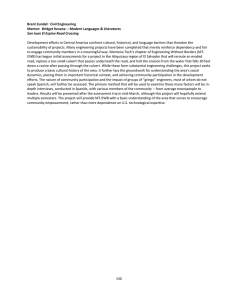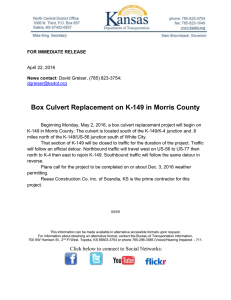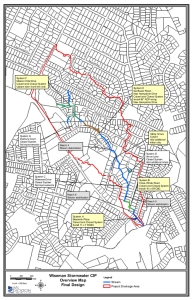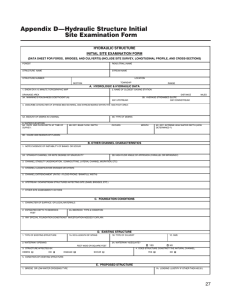the Hydraulic Design of Culverts
advertisement
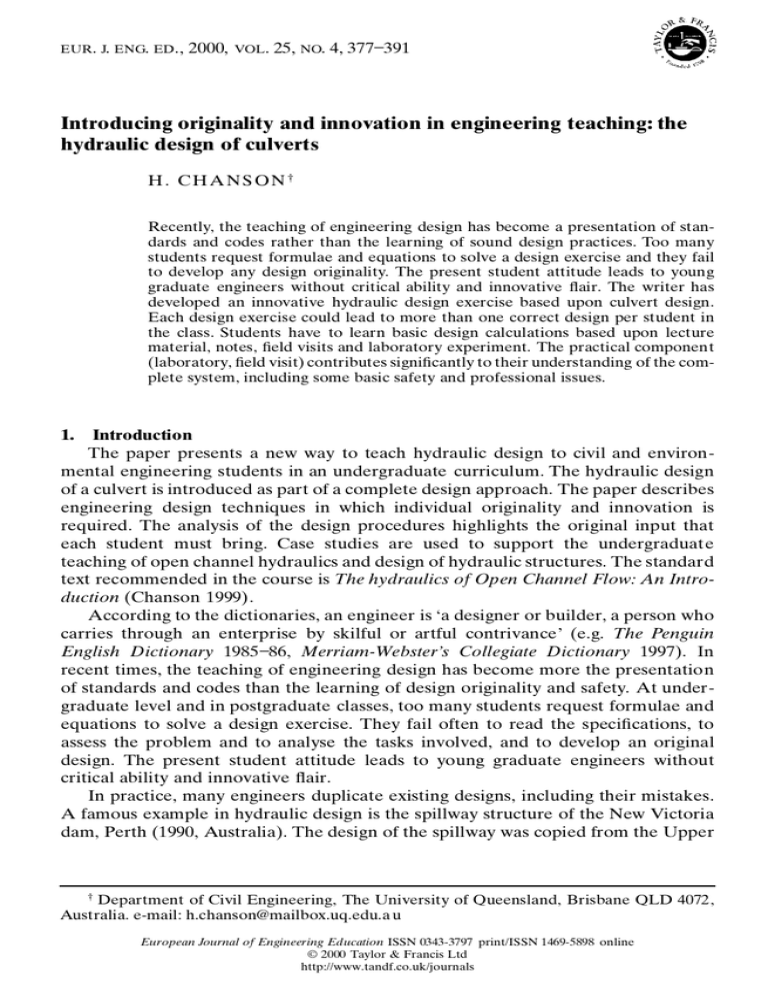
EUR. J. ENG. ED., 2000, VOL. 25, NO. 4, 377–391 Introducing originality and innovation in engineering teaching: the hydraulic design of culverts H . C H A N S ON † Recently, the teaching of engineering design has become a presentation of standards and codes rather than the learning of sound design practices. Too many students request formulae and equations to solve a design exercise and they fail to develop any design originality. The present student attitude leads to young graduate engineers without critical ability and innovative air. The writer has developed an innovative hydraulic design exercise based upon culvert design. Each design exercise could lead to more than one correct design per student in the class. Students have to learn basic design calculations based upon lecture material, notes, eld visits and laboratory experiment. The practical component (laboratory, eld visit) contributes signicantly to their understanding of the complete system, including some basic safety and professional issues. 1. Introduction The paper presents a new way to teach hydraulic design to civil and environmental engineering students in an undergraduate curriculum. The hydraulic design of a culvert is introduced as part of a complete design approach. The paper describes engineering design techniques in which individual originality and innovation is required. The analysis of the design procedures highlights the original input that each student must bring. Case studies are used to support the undergraduate teaching of open channel hydraulics and design of hydraulic structures. The standard text recommended in the course is The hydraulics of Open Channel Flow: An Introduction (Chanson 1999). According to the dictionaries, an engineer is ‘a designer or builder, a person who carries through an enterprise by skilful or artful contrivance’ (e.g. The Penguin English Dictionary 1985 –86, Merriam-Webster’s Collegiate Dictionary 1997). In recent times, the teaching of engineering design has become more the presentation of standards and codes than the learning of design originality and safety. At undergraduate level and in postgraduate classes, too many students request formulae and equations to solve a design exercise. They fail often to read the specications, to assess the problem and to analyse the tasks involved, and to develop an original design. The present student attitude leads to young graduate engineers without critical ability and innovative air. In practice, many engineers duplicate existing designs, including their mistakes. A famous example in hydraulic design is the spillway structure of the New Victoria dam, Perth (1990, Australia). The design of the spillway was copied from the Upper † Department of Civil Engineering, The University of Queensland, Brisbane QLD 4072, Australia. e-mail: h.chanson@mailbox.uq.edu.a u European Journal of Engineering Education ISSN 0343-3797 print/ISSN 1469-5898 online © 2000 Taylor & Francis Ltd http://www.tandf.co.uk/journals 378 H. Chanson Stillwater dam (1987, USA). The US design was to be a 4.6-m long broad crest followed by a straight 59º stepped chute, but the nal design is a 9.1-m long broad crest followed by a 72º chute and then a 59º chute. The change in design was made to allow truck access. It had no hydrodynamic or structural validity. In fact, the nal design has increased the risks of jet deection and improper operation during overows at the transition between the crest and the 72º chute. None the less, the Upper Stillwater crest design was duplicated for the New Victoria dam spillway without critical analysis (Chanson 1997). The author has developed an innovative hydraulic design exercise which could lead to more than one correct design per student in the class. Students must develop their individual expertise in culvert design. They have to learn how to calculate an efcient design based upon lecture material, notes, eld visit(s) and laboratory experiment. They are expected to provide detailed drawings and justications of their calculations. 1.1 Culvert design A culvert is a covered channel of relatively short length designed to pass water through an embankment (e.g. highway, railroad, dam). The design requires a hydrological study of the upstream catchment to estimate the maximum (design) discharge and the risks of exceptional (emergency) oods. The dimensions of the culvert are based on hydraulic, structural and geotechnical considerations. Indeed, the culvert height and width affect the size and cost of the embankment. The culvert impact on the environment must also be taken into account, e.g. ooding of the upstream plain. The design process is a system approach. The system must be identied as well as the design objectives and constraints. A detailed analysis of it must be conducted and the engineers should ask if their nal design responds to the objectives. 2. Hydraulic design of culvert The hydraulic performances of a culvert are the design discharge Qdes, the upstream total head and the maximum (acceptable) head loss D H. Head losses must be minimized to reduce upstream backwater effects (i.e. upstream ooding). The primary design constraints are: (1) the cost must be (always) minimum; (2) the afux1 must be small and preferably minimum; (3) eventually the embankment height may be given or may be part of the design; and (4) a scour protection may be considered, particularly if a hydraulic jump might take place near the culvert outlet. The hydraulic design is basically an optimum compromise between discharge capacity and head loss. In practice, short culverts are designed for free-surface ow with critical ow conditions2 in the throat. The nal design may vary from a simple geometry (i.e. standard box culvert) to a hydraulically-smooth shape (i.e. minimum energy loss (MEL) culvert3) (gures 1 and 2). 3. Standard culverts A standard culvert is designed to pass water at minimum cost. The culvert construction must be simple, e.g. circular pipes, precast concrete boxes. The culvert ow may exhibit various ow patterns, e.g. free-surface inlet ow conditions or submerged entrance, inlet control or outlet control (gures 1 and 3).4 The discharge capacity of the barrel is primarily related to the ow pattern. Originality and innovation in teaching Figure 1. Sketch of a standard culvert operation: inlet control and outlet control. 379 380 H. Chanson Figure 2. Sketch of a minimum energy loss culvert. When free-surface ow takes place in the barrel, the discharge is xed only by the entry conditions, and the discharge is typically estimated as: Q 2 —– = CD * —– * B 3 Q —– = C*D* B Ö Ö 1 2 2 —– *g *(H1 – zinlet)1.5 3 Free-surface inlet ow (1) [2*g*(H1 – zinlet – C*D)] Submerged entrance and free-surface barrel ow (2) where B is the barrel width and D is the barrel height (gure 1) (Henderson 1966). CD equals 1 for rounded vertical inlet edges and 0.9 for square-edged inlets. C equals 0.6 for square-edged soft and 0.8 for rounded soft. For drowned culverts (i.e. outlet control), the discharge is determined by the culvert resistance (i.e. primary and secondary losses) (e.g. US Bureau of Reclamation 1987, Concrete Pipe Association of Australasia 1991). 3.1. Design procedure For standard culverts the design process is divided into two parts (e.g. Herr and Bossy 1965, HEC No. 5). First, a system analysis must be carried out to determine the objectives of the culvert, the design data, the constraints including the design ow Qdes and the design upstream total head Hdes. 381 Originality and innovation in teaching (a) (b) Figure 3. Examples of model box culvert operation. Design ow conditions: Qdes = 10 ls–1, dtw = 0.038 m, So = 0.0035, Bmin = 0.15 m, D = 0.107 m, Lculv = 0.5 m. (a) Design ow conditions: view from upstream (ow from bottom right to top left): Q = 10 ls–1, dtw = 0.038 m, d1 = 0.122 m. Note the hydraulic jump downstream of the culvert. (b) Non-design ow conditions: view from upstream of the drowned barrel (ow from bottom right to top left): Q = 10 ls–1, dtw = 0.109 m, d1 = 0.133 m, outlet control. 382 H. Chanson In a second stage, the barrel size is selected by a test-and-trial procedure, in which both inlet control and outlet control calculations are performed. At the end, the optimum size is the smallest barrel size allowing for inlet control operation. Calculations of the barrel size are iterative: (1) Choose the barrel dimensions. (2) Assume an inlet control. Calculate the upstream total head corresponding to the design discharge Qdes assuming inlet control for different barrel sizes until the upstream head H1(ic) satises the design specications (i.e. H1(ic) = Hdes). (3) Assume an outlet control. Use design charts to calculate the head loss D H from inlet to outlet for the design discharge Qdes (e.g. US Bureau of Reclamation 1987). Calculate the upstream total head H1(oc): H1(oc) = Htw + D H, where Htw is the tailwater head at design ow. (4) Compare the inlet control and outlet control results: Hdes = H1(ic) _ H1(oc). The larger value controls. When the inlet control design head Hdes (used in step 2) is larger than H1(oc), inlet control operation is conrmed and the barrel size is correct. If H1(oc) is larger than Hdes, outlet control takes place. Step 3 must be then repeated with an increased barrel size until H1(oc) satises the design specication Hdes. 4. Minimum energy loss culverts A MEL culvert is a streamlined structure designed with the concept of minimum head loss (gures 2 and 4). Apelt (1983) presented an anthoritative review of the topic. The basic design concepts are streamlining and critical ow conditions (a) Figure 4. Photographs of a prototype MEL culvert below Ridge Street, Brisbane, Queensland, Australia. Design discharge: 220 m3s–1; barrel: 7 cells (2-m-wide each). (a) View of the inlet: a bicycle path passes in one of the barrel cell. (b) View of the outlet. Note the low-ow channel in the foreground (left) and the bicycle path behind. 383 Originality and innovation in teaching (b) 384 H. Chanson through all the waterway (inlet, barrel, outlet) (gure 5). The intake is designed with a smooth contraction into the barrel while the outlet (or diffuser) is shaped as a smooth expansion back to the natural channel. In a satisfactory design, the ow streamlines follow very smooth curves and no separation is observed as for a Venturmeter installed in a circular pipe. MEL structure are designed to achieve critical ow conditions in all the engineered waterway because the maximum discharge per unit width for a given specic energy is achieved at critical ow conditions (e.g. Henderson 1966). At the throat the discharge per unit width may be increased by lowering the barrel invert below the natural ground level. 4.1. A simple design method Professor C. J. Apelt (The University of Queensland) proposed a simple method to calculate the basic characteristics of a MEL culvert. This method gives a preliminary design.5 Full calculations using the backwater equations are required to predict accurately the free-surface prole. 1. Decide the design discharge Qdes and the associated total head line (THL) in the ood plain. (A) Neglect energy losses 2.1. Calculate the waterway characteristics in the throat (i.e. barrel) for critical ow conditions. 2.2. Calculate the inlet width Bmax assuming critical ow conditions and natural bed level (i.e. D zo = 0). 3.1. Decide the shapes of the fans. 3.2. Calculate the geometry of the fans to satisfy critical ow conditions everywhere (e.g. gure 7). In the above steps, either the barrel width Bmin is selected and the barrel invert drop D zo is calculated; or D zo is chosen and the barrel width is calculated. (B) Include the energy losses 4. Adjust the bed prole of the waterway to take into account the energy losses. 5. Check the ‘off-design’ performances, i.e. Q > Qdes and Q < Qdes. 5. Teaching culvert design The author developed a pedagogic tool to introduce students to culvert design. It covers lecture material, home work associated with site visit(s) as well as a culvert laboratory study which includes an audiovisual presentation, physical models of culverts and numerical computations (using the program HydroCulv). The aim of the course is to introduce students to some original hydraulic design as well as to hydraulic computations of culvert design using a commercial package. Following the lecture material, students are involved in home work associated with site visit(s) (individually or in groups). For a particular case study, the students are asked either to design a standard box culvert for a specied ow rate or to calculate the design discharge capacity of an existing structure, and the associated upstream water levels. Then they are requested to design a MEL waterway to pass a specic ood (e.g. 1 in 50 years ood) and to compare their design with the corresponding standard box culvert. For each site, there is usually a single optimum standard culvert design and a multitude of correct MEL design. The multiplicity of Figure 5. Free-surface prole assumed in the ‘simple design method’. Originality and innovation in teaching 385 386 H. Chanson MEL culvert designs results from the wide range of inlet and outlet shapes, e.g. parabolic, elliptic or hyperbolic sidewall curves. Considering a practical application, the culvert design parameters are: design discharge = 100 m3s–1, barrel width = 8 m, zero afux.6 The students are asked to design a box culvert with zero afux, a box culvert with an 8-m-wide barrel and a MEL culvert with zero afux and an 8-m-wide throat. A standard box culvert with invert set at ground level would need to be 50-m-wide to pass the ood without afux, while an 8-m-wide box culvert would cause an upstream water level rise (afux) of about 4.4 m (gure 6). The MEL culvert design would require a 2.6-m deep excavation of the barrel. Figure 7 (a, b) shows proper inlet designs that would pass the design ow rate with zero afux. Each gure shows the sidewalls and centreline invert elevation only. Figure 7(c) presents an improper design that would create some upstream ooding for ow rates larger than 60% of the design ow rate.7 Note the signicant differences between the standard and MEL culvert designs. The MEL waterway concept was developed by Profs G. R. McKay and C. J. Apelt for the coastal plains of Queensland (North-East of Australia). Torrential rains during the wet season, associated with very small natural plain ood slope (So ~ 0.001) and little fall (or head loss), place a heavy demand on culverts. During each case study, the students may choose a multitude of inlet shapes. A correct design must be streamlined with occurrence of critical ow conditions at any location between the inlet lip and barrel. The complete inlet design requires the drawings of the lines of constant invert elevation. These are equipotential lines and the complete inlet design is similar to a ow net analysis (e.g. Vallentine 1969). 6. Laboratory work Each student spends one afternoon in a hydraulic laboratory (see the appendix). The students are rst introduced to culvert design (video presentation, Apelt 1994) before performing measurements in a standard box culvert model (gure 3) and a downstream MEL culvert model (gure 4). The models discharge an identical ow rate. They are made of breglass and perspex, and the students can see the ow patterns in the channel, barrel, inlet and outlet for design and non-design ow conditions8 (gure 3). Identical ow conditions are input to a commercial software for standard culvert design (e.g. HydroCulv). Comparisons between the physical model and computer program results are conducted and discussed with the help of the physical model. The comparative performances of standard and MEL culverts are also discussed for design and non-design ow conditions. At the end of the afternoon, the students are challenged on the effect of a ood larger than the design ow. Their response is discussed in a group before being tested in the physical models for 1.5*Qdes. 7. Discussion: a teacher’s opinion The author has taught hydraulic design at undergraduate and postgraduate levels for more than 10 years. At undergraduate levels, he introduces the students to spillway and culvert design. It is the author’s opinion that the hydraulic design of a culvert offers a unique opportunity. The design exercise is based upon very basic hydraulic material, i.e. the concept of specic energy, critical ow conditions, idealuid ow. Each case study may be developed as a series of design exercises with increasing complexity, e.g. starting with a standard culvert design and ending with a Figure 6. Free-surface computations for a standard box culvert (program HydroCulv). Design parameters: design ow rate = 100 m3s–1; barrel width: 8 m; normal depth in the ood plain (in absence of culvert): 1.2 m. Originality and innovation in teaching 387 388 H. Chanson (a) (b) Figure 7. MEL culvert design. Design parameters: design ow rate = 100 m3s–1; barrel width: 8 m; zero afux; normal depth in the ood plain (in absence of culvert): do = 1.2 m. (a) Correct design. (b) Correct design. (c) Improper design: upstream ooding will occur for Q > 58 m 3s–1. Originality and innovation in teaching 389 (c) MEL culvert design. Further, many case studies may be based upon prototype culverts. Standard culverts are very common and the students can inspect several sites. In Brisbane, there are, further, a number of MEL culverts that are easily accessible (e.g. gure 4). The practical component of the teaching is very important, i.e. the eld trip and laboratory experiment. The writer’s experience suggests that students gain an optimum understanding when all teaching components are combined, i.e. lecture material, eld visit, design exercise and laboratory experiment. The laboratory experiment is most useful to conduct comparisons between standard and MEL culvert performances, and also comparisons between physical modelling and computations. 9 The eld trips are often conducted with the lecturer and sometimes with professional engineers. The students learn of all the technical aspects of a culvert: road, embankment, boxes or pipes, drainage, etc. They can further picture the effects of upstream ooding. In the case of a MEL culvert, the students can appreciate the barrel and inlet design, the low-ow channel design. They are often surprised by the small excavation depth, not often perceptible. By the end of the course, most students realize their ability to undertake the critical analysis of a professional design. They further understand that there might be more than one solution, and that the optimum design might be selected for nontechnical reasons, e.g. politics when the Lord Mayor lives upstream of a new culvert! Conclusion The writer has developed an innovative hydraulic design exercise based upon culvert design. It aims to challenge the critical ability and innovative air of the 390 H. Chanson students, as indeed each design exercise may lead to more than one correct design per student in the class. Students have to learn basic design calculations based upon lecture material, notes, eld visits and laboratory experiment. The practical component (laboratory, eld visit) contributes signicantly to their understanding of the complete system, including some basic safety and professional issues. It is the author’s opinion that the described teaching method has been very successful in the context of Australian civil and environmental engineering students. He further believes that the eld visit under the supervision of the lecturer and sometimes of professional engineers gives an added dimension to the hydraullic design teaching. Acknowledgements The author thanks especially Prof. Colin J. Apelt, University of Queensland, for his help and assistance. The technical background of the paper derived from Prof. Apelt’s personal lecture notes. Appendix: Laboratory components Audio-visual material: Apelt, C. J., 1994, The minimum energy loss culvert, Video-cassette VHS colour, Department of Civil Engineering, University of Queensland, Australia, 18 min. Physical model (standard culvert): The physical model characteristics are: Qdes = 10 ls–1, Bmax = 1 m, Bmin = 0.15 m, D = 0.11 m, Lculv = 0.5 m, dtw = 0.038 m, intake and outlet: 45º diffuser, So = 0.0035. Physical model (MEL culvert): The physical model characteristics are: Qdes = 10 ls–1, Bmax = 1 m, Bmin = 0.10 m, D = 0.17 m, barrel length: 0.6 m, dtw = 0.038 m, barrel elevation 0.124 m lower than river bed. Computer program: HydroCulv Version 1.1 (HydroTools Software: dwilliams@compusmart.ab.ca). Notes 1. The afux is the rise of water level above normal free-surface level upstream of the culvert. It is a measure of the upstream ooding caused by the culvert design. 2. In open channel ows, the ow conditions, such as the specic energy is minimum, are called the critical ow conditions (e.g. Henderson 1966, Chanson 1999). 3. The design of a MEL culvert is associated with the concept of constant total head. The inlet and outlet must be steamlined in such a way that signicant form losses are avoided. For an introduction on MEL culverts, see Apelt (1994). For a complete review of MEL waterways, see Apelt (1983). 4. Inlet control occurs when the ow is controlled by the upstream ow conditions and the ow rate is independent of the downstream water level. 5. The simple method is based on the assumption that the ow is critical from the inlet to outlet lips including in the barrel. 6. Other design parameters are: normal depth in the ood plain = 1.2 m (in absence of culvert), bed slope = 0.005, culvert length = 24 m. Barrel height = 3 m. 7. The extent of the upstream ooding could be determined with detailed backwater computations and physical modelling. 8. The experiments are conducted with ow rates ranging from 0.05 to 1.5 times the design discharge. 9. Most professional softwares perform one-dimensional or two-dimensional calculations. They fail to address the three-dimensional nature of the ow that may be visualized in the physical model. Originality and innovation in teaching 391 References APELT, C. J., 1983, Hydraulics of minimum energy culverts and bridge waterways. Australian Civil Engineering Transactions, CE25, 89–95. APELT, C. J., 1994, The minimum energy loss culvert, Videocassette VHS colour, Department of Civil Engineering, University of Queensland, Australia, 18 min. CHANSON, H., 1997, A short history of stepped cascades in Australia. ANCOLD Bulletin, 106, 101 –111. CHANSON, H., 1999, The Hydraulics of Open Channel Flows: An Introduction (London: Edward Arnold). CONCRETE PIPE ASSOCIATION OF AUSTRALIA, 1991, Hydraulics of Precast Concrete Conduits (Jenkin Buxton Printers, Australia). HENDERSON, F. M., 1966, Open Channel Flow (New York: MacMillan). HERR, L. A. AND BOSSY, H. G., 1965, Hydraulic Charts for the Selection of Highway Culverts. Hydraulic Eng. Circular, US Dept. of Transportation, Federal Highway Admin., HEC No. 5, December. US DEPARTMENT OF THE INTERIOR, 1987, Design of Small Dams. Denver CO: Bureau of Reclamation. VALLENTINE, H. R., 1969, Applied Hydrodynamics (London: Butterworths). About the author Hubert Chanson received a degree of ‘Ingénieur Hydraulicien’ from the Ecole Nationale Supérieure d’Hydraulique et de Mécanique de Grenoble (France) in 1983 and a degree of ‘Ingénieur Génie Atomique’ from the ‘Institut National des Sciences et Techniques Nucléaires’ in 1984. He worked for industry in France as a R&D engineer at the Atomic Energy Commission from 1984 to 1986, and as a computer professional in uid mechanics for Thomson-CSF between 1989 and 1990. From 1986 to 1988, he studied at the University of Canterbury (New Zealand) as part of a PhD project. In 1999, he was awarded a Doctor of Engineering at the University of Queensland. He has been a senior lecturer in uid mechanics, hydraulics and environmental engineering at the University of Queensland since 1990. His research interests include design of hydraulic and coastal structures, experimental investigations of two-phase ows, water modelling in coastal and hydraulic structures, environmental management and natural resources, and engineering heritage. He has authored three books: Hydraulic Design of Stepped Cascades, Channels, Weirs and Spillways, Air Bubble Entrainment in Free-surface Turbulent Shear Flows and The Hydraulics of Open Channel Flows: An Introduction. His publication record includes over 160 international refereed papers. Dr Chanson has been active also as consultant for both governmental agencies and private organizations. He has been awarded four fellowships from the Australian Academy of Science. In 1995 he was a Visiting Associate Professor at National Cheng Kung University (Taiwan ROC) and he was a Visiting Research Fellow at Toyohashi University of Technology (Japan) in 1999. Dr Chanson was the keynote lecturer at the 1998 ASME Fluids Engineering Symposium on Flow Aeration and at the Workshop on Flow Characteristics around Hydraulic Structures (Nihon University, Japan 1998). He gave an invited lecture at the International Workshop on Hydraulics of Stepped Spillways (ETH-Zürich, 2000). He lectured several short courses in Australia and overseas (e.g. Japan, Taiwan).
